4x4 Editorial at OKoffroad.com
Synthetic Winch Rope
 More Winch Rope Info
More Winch Rope Info
reprinted with permission
Based on experience gained during off-road challenges and
adventures since the introduction of synthetic winch rope to the 4X4 market, several specific
end-use conditions have been identified. The presence of these conditions can best be determined
by periodic inspection of the lines and the hardware on which it operates.
Before mounting your new winch rope, carefully inspect the winch drum, winch flanges, and any
winding aids, rope guides, or running surfaces where the rope comes in contact with metal
portions of the vehicle. Feel these surfaces by hand to ensure they are free from nicks, burrs,
rust, or sharp edges. All running surfaces should be rounded to at least the same diameter as
the rope. Check that the drum surface is also free of gouges. It should be smooth, but not too
smooth, as the rope needs a little friction to prevent it from turning freely on the drum.
Periodic checks of the winch and winch mount area is recommended.
A Note on the Fairlead:
We recommend not to use a roller fairlead with synthetic winch rope. Why? For many reasons:
- Winch rope is designed to flatten-out under load, and therefore could get pinched in the corners
of a roller fairlead.
- A steel roller (even a new one) gets weatherized and rusted quickly (see image below) and is
not good for the rope.
- Synthetic winch rope is actually too smooth to roll the roller.
- An old roller fairlead is not good for the rope, especially if scuffed.
- A roller fairlead is much heavier.
- A roller fairlead sticks out further, reducing approach angle.
- Bolts, or spindles with C-clips on a roller might cause a winch rope to snag. Our aluminum
fairlead has nothing in front for the rope to catch on.
Example of a badly weathered & rusted roller fairlead
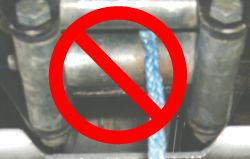
(click image for large view)
We strongly recommend upgrading to a billet aluminum Hawse fairlead or a roller fairlead with poly rollers to prevent damage from a
scuffed roller fairlead. And a steel Hawse fairlead designed for use with cable is an even bigger no-no for winchrope.
A Note on the Winchrope:
It should be noted that normal light fuzzing of the winch rope surface is to be expected in
normal use. This light fuzzing does not reduce the rated strength of the line, but actually
creates a layer on the rope that protects it. External protection against chafing (e.g. our
included 10' abrasion guard) should always be used where the rope will contact sharp or abrasive
objects when winching.
Repeated lateral abrasion against sharp edges is to be avoided. While HMPE is one of the
most cut-resistant polymers available, hard rough-surfaced materials (rocks, sharp metal) can
prove to be stronger in a long-duration abrasion event. Signs of excess abrasion include strand
pull-outs, heavy chafing, and/or cut strands in a single area. Our aluminum Hawse fairlead is
recommended to avoid metal abrasion from a scuffed and/or weatherized roller fairlead.
A Note on Salt Water:
"Salt water has no effect on synthetic winch rope. It is a closed fiber rope so the salt water
does not absorb or penetrate into the fibers, so the strength retention is the same as if the
rope was never in water or salt water."
A Note on Winchrope & Snow Plowing:
If in use for snowplow lifting do not use abrasion guard at the front of the rope. Slide it down
the line out of the way and spool onto drum.
A Note on the Winch Hook Hammerlock:
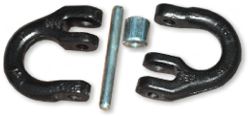
(click image for large view)
Our Hammerlocks are easy to assemble, and as the name suggests require a hammer to do so. Think
of this device as a simple hinge, and every hinge has a center pin. Click
HERE for installation instructions!
Using your winch in accordance with the manufacturer’s recommendations should cause no
overheating of your winch rope. It should be noted that sometimes the rope remaining on the
winch drum might appear to be fused, melted or deformed. However, this is not caused by
overheating but is a result of compression when the winch line is heavily loaded. Flexing the
rope by hand to separate the strands can soften up this stiff section, a process that causes no
damage to the fibers.

Dyneema Fiber RopeIt'll stop a bullet!
reprinted with permission
Click Here for more technical info

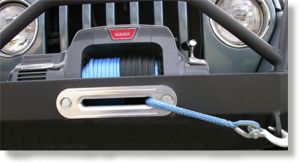
(click image for large view)
Installing the Rope on your winch:
We recommend installing the rope on the winch in an open area (trail or field) with a suitable
anchor point (tree) available. Attach the terminal end of the rope to the drum with the winch set
screw. Note that the surface and sides of the drum should be free of burrs of any kind, but
should also not be so smooth, with a glossy surface that the rope will not grab on the surface of
the drum. Ideally, it should have a matt, or somewhat roughened finish. Go over it with a piece
of emery paper if necessary to achieve this non-glossy finish. With tension, spool on the first
layer, plus one or two wraps. Then with the hook attached to a tree saver around the anchor point
(tree) a suitable distance from the vehicle, use the rolling resistance of the vehicle (in
neutral with emergency brake off), and spool the rope onto the drum, pulling the vehicle towards the anchor point.
This is not the correct way to install winchrope
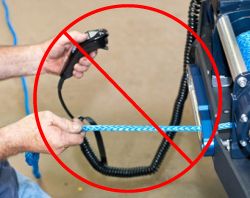
(click image for large view)
We recommend not spooling the rope in to where the hook and thimble are up against the aluminum
Hawse fairlead, which might cause the polished aluminum surface to be scratched from the steel
thimble and/or hook. Instead we recommend attaching the hook onto one of the front recovery points to
the left or right on the front bumper. When doing this, use a D-ring shackle in a
recovery point designed for a D-shackle. Do not slip the hook into it (square peg in a round
hole - we've seen people do it), as it will prevent the hook from pivoting in the right direction when
spooled in, and could lead to the thimble getting distorted.
A Note on the Terminal End:
The terminal end (drum connector) is there to prevent the rope from unraveling. It is not a load-bearing tie-down.
The terminal end is professionally glued and crimped, and is designed to withstand a certain
amount of pull. Improper installation of the rope, or spooling out to the last layer of drum,
causing a full load pull to be exerted on the terminal end, however, will cause the terminal end
to release the rope, as it is designed to do. This set-up prevents the winch set screw from
pulling out of the drum.
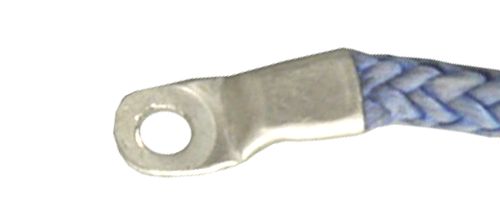
(click image for large view)
The terminal end installed on the drum-end of the rope is designed for many
popular winch applications. Our 3/16" ATV winchrope is assembled with heat-shrunk drum end (no
terminal end) for ease of mounting. If your winch has another typed of tie-down method - no problem -
give us a call, and we'll explain how to modify it for your application.
A Note on the Winchrope Retainer:
Our winchrope retainer is a simple device which makes the installation of winchrope on a winch
drum totally idiotproof (see winchrope installation instructions below). A common installation fault is not using a
strong enough resistance to ensure a tight wrap of the winchrope on the drum. Using the
winchrope retrainer will ensure that the rope will not pull through to the terminal end even if
the winchrope is not initially spooled on the drum as snug as it should be.
Click
HERE for installation instructions!
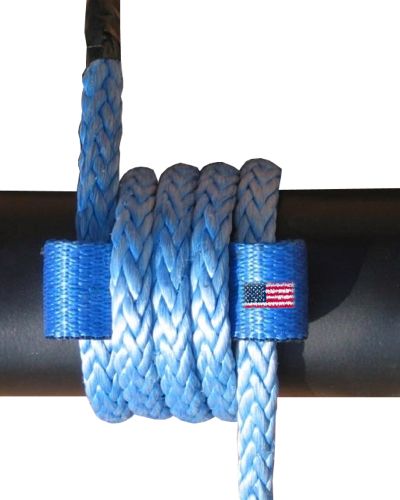
(click image for large view)
A Note on the Rope Thimble:
We use a heavy-duty galvanized steel thimble at the looped hook-end of the rope. You will notice
that the thimble is wider than the diameter of rope to help protect from abrasion. If using a
factory winch hook that came with the original cable ensure that the clevis opening on the hook
is wide enough to allow the thimble plenty of wiggle room. Do not under any circumstances alter
the width of the thimble by hammering or compressing in a vice to make it fit. This reduces the
structural integrity of the thimble and will cause it to deform.

(click image for large view)
If securing the rope onto a recovery point when spooled, make sure to use a D-shackle for the
hook. Do not store the hook directly into the recovery point. This will cause a lateral pull on
the thimble when spooling-in which could lead to deforming.
A Note on the Abrasion Guard:
The 10 ft. abrasion guard (5 ft. on ATV rope) stays permanently on the winch rope. When spooling
in the rope, the guard will slide to the hook end, and the handler who is usually facing the
winch, gets a 10 ft. warning that the hook is coming. Lift the beginning of the guard over the
lip of the aluminum Hawse fairlead, and the guard and rope will spool onto the winch drum without
bunching up.
During winching, slide the guard along the rope to the rock or outcrop that might abrade the rope.
The guard will rest on the object permitting the rope to slide through the guard without any
abrasion.
General Note:
Winch rope, just like winch cable can lose strength if overstrained. Overstraining is the result
of exceeding the recommended working load limit, whether instantaneously (by transient peak
loads during dynamic loading events) or for an extended time period (by overworking the
winch and/or rope). The working load limit of the line should be chosen based on experience in
the end use, along with consultation with OKoffroad, your winch and rope supplier. Make sure
your rope diameter and winch capacity are suitable for your vehicle size.
. |
Click Here for more technical info on
Amsteel Blue Winch Rope

Froading for me: "Having the ability and skill to venture from the paved corridors
using primitive roads and 2-tracks to explore the world that is seldom seen and see nature at its
best"
Bill Burke

(Thank you from OKoffroad.com)

Froading for me:
"Family Time. Yep, the kids all got jeeps and Mom and Dad were
not about to be left in camp cooking. So at the young age of 50, let's
make memories on the mountains. Oh, and if the kids see this, It is your
turn to cook! Mom and Dad are "Mudding!"
Dave & Sidney Hayes
Napa, CA
Froading for me:
"The closest I can get to Hot Rodding and Nature @ the same time!"
Brian Churchwell
Noble, OK
Froading for me:
"Fun friends & four wheel drives - who could ask for more."
Travis Lineberger
Okmulgee, OK
Froading for me:
"My escape from the working world, all the stress from the rest of life, thank goodness for
my fj40!"
Scott Paswaters
Holladay, Utah

3/16" & 1/4"
ATV Winch Rope
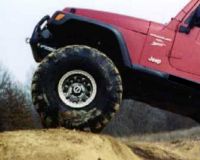
5/16" & 3/8"
4X4 Winch Rope
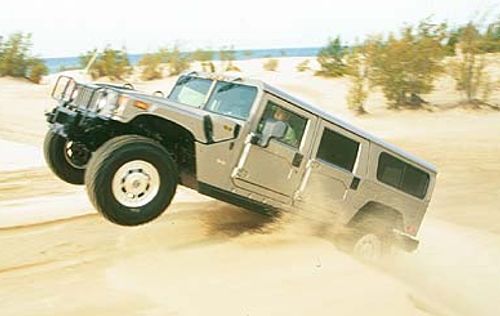
Hummer/SuperDuty
7/16" & 1/2" Winch Rope
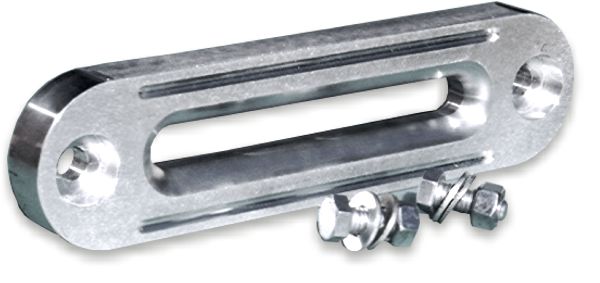
Aluminum Fairlead
















